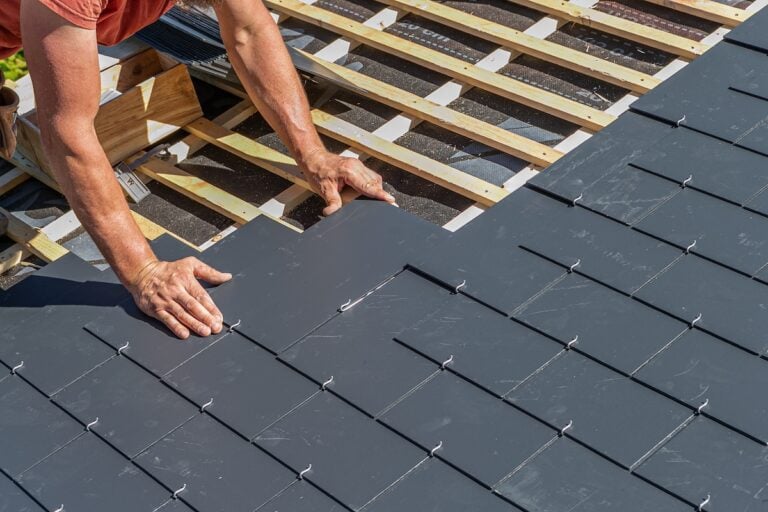Wondering how to pay for a new roof without draining your savings? Roof replacements are a significant investment, and understanding your financing options can make the process much less stressful. Whether your roof has aged out or was damaged in a recent storm, there are flexible and practical ways to fund the work.
In this guide, you’ll learn:
- Common ways homeowners cover roof replacement costs
- Pros and cons of different financing methods
- Tips to prepare financially for your roofing project
💵 Why Roof Replacement Costs Add Up
The price of a new roof goes beyond just the materials. A complete replacement includes removal of old roofing, underlayment, flashing, labor, and disposal fees. Other variables include the pitch of your roof, square footage, material choice, and whether structural repairs are needed. Compare the metal roof vs shingles cost to see how long-term value factors in.
For most homeowners, paying for a roof out of pocket is unrealistic without preparation. That’s why exploring financing early in the process is smart.

✅ 5 Financing Options for a New Roof
Each household has different financial needs and credit histories, so it’s important to review multiple funding options.
- Cash savings: Using personal savings is the most straightforward method. It avoids interest payments and long-term debt but may deplete your emergency funds. This option works best for those who have been saving specifically for home improvements or who maintain a well-stocked emergency fund. Keep in mind that draining your savings may limit your ability to respond to other unexpected expenses.
- Credit cards: For smaller roofing projects, credit cards offer convenience and fast access to funds. However, interest rates are typically high unless you qualify for a 0% introductory offer. This option is best used for minor repairs or as a short-term bridge while exploring other financing options. Be cautious with large balances that can accrue significant interest over time.
- Home equity loan or HELOC: These use your home as collateral, offering lower interest rates and longer repayment terms. They’re ideal for large projects if you have sufficient equity and good credit. A home equity loan provides a lump sum, while a HELOC works more like a credit line, offering flexibility for phased projects. Be aware that failure to repay could put your home at risk.
- Personal loan: Unsecured personal loans are widely available and require no collateral. They work well for mid-sized budgets but may come with higher rates depending on your credit. Lenders typically offer fixed terms and predictable monthly payments, which helps with budgeting. This can be a great choice if you need funds quickly and don’t want to use your home as collateral.
- Roofing company financing: Some contractors partner with third-party lenders to offer structured payment plans. Terms vary, so review details carefully before committing. These plans may offer promotional rates, same-as-cash periods, or deferred payments depending on the provider. It’s important to read the fine print to understand total repayment obligations and any penalties. Some roofing contractors in Arlington even partner with lenders to provide flexible in-house financing.
⭐️ Budgeting Tips Before You Finance
A little preparation can go a long way in avoiding financial strain.

Get Multiple Quotes
Always compare several roof estimates to get a sense of fair pricing. Some contractors may bundle services, offer seasonal discounts, or include longer warranties—all of which impact the value you receive. Requesting quotes from at least three companies can help identify potential red flags or unusually low estimates. Understanding what’s included in each bid ensures you’re comparing apples to apples. Always compare several roof estimates in Alexandria to ensure you’re getting fair pricing and value.
Check Your Credit Score
Many financing options depend on your credit profile. Before applying for a loan, pull your credit report, address any errors, and understand where you stand. A higher credit score can unlock better interest rates and more favorable terms. If your score is lower than you’d like, take steps to improve it before applying.
Factor in Future Costs
Beyond initial replacement, consider what you’ll need in 5, 10, or 20 years. Choosing a longer-lasting material might cost more upfront but can save you from repeating the process too soon. Also, factor in potential maintenance, warranty coverage, and future energy efficiency. These long-term savings can often justify a higher upfront investment.
👉 Pros and Cons of Roof Financing
Understanding the benefits and trade-offs of financing helps you make an informed decision.
- Flexibility: Financing gives you the ability to start your project immediately without waiting to save up the full amount. This can be especially helpful when facing urgent repairs or damage that can’t be postponed. Access to funds right away means less risk of further deterioration or added costs from delays.
- Higher total cost: Most financing methods include interest, which increases your overall spending. Over the course of several years, this interest can add up significantly depending on the loan terms. It’s important to weigh the added cost of interest against the benefit of spreading payments out over time.
- Access to better materials: With more budget flexibility, you may opt for higher-quality roofing that offers longer warranties or better energy efficiency. Investing in premium materials can reduce the likelihood of future repairs or replacements. It also adds potential resale value and performance benefits to your home. Financing may let you upgrade to premium options like stone-coated steel roofing for longer-lasting performance.
- Monthly obligations: Payments must be factored into your household budget to avoid missed deadlines or penalties. Consistently meeting these payments is crucial to protect your credit score and maintain financial health. Planning your monthly expenses in advance ensures you can manage this new commitment comfortably.

❗️ Planning Ahead Can Save You Stress
Even if you don’t need a new roof today, it helps to know how to pay for a new roof before it becomes urgent. Regular inspections, saving gradually, and maintaining good credit all help when the time comes.
If you’ve dealt with unexpected issues like storm damage roof repair in Great Falls, planning ahead can ease financial strain. Roof replacement is a major investment, but with the right plan in place, it doesn’t have to be overwhelming.
🤝 Talk to a Roofing Expert You Trust
Before committing to any financing plan, speak with a reputable roofing professional. They can help you evaluate the scope of the project and may even provide insight into which financing options fit your goals best.
Explore your options carefully, plan ahead, and stay informed—you’ll be in a much better position to protect your home and budget when it’s time for a new roof. Contact us to learn more about our financing options!






